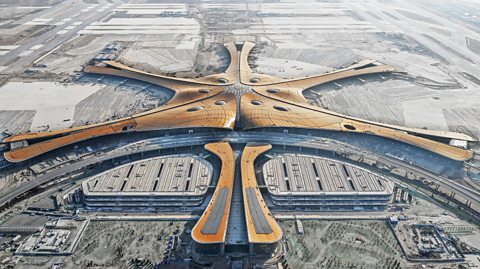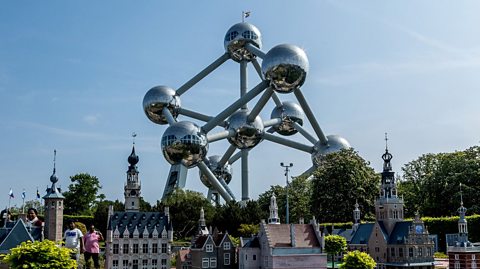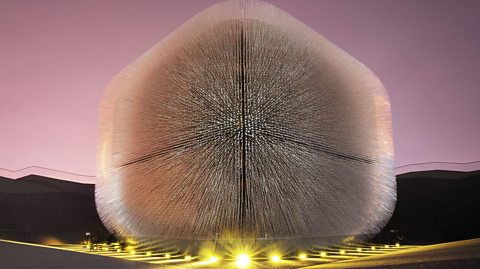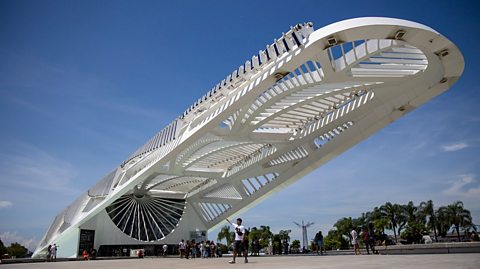Flying vehicles, soaring skyscrapers and floating freeways.
Just a few of the things associated with futuristic cityscapes. It may feel like these innovative features are reserved for the sci-fi worlds of Star Wars or Blade Runner, but the world is already peppered with buildings that look like theyâre from the future.
±«Óătv Bitesize takes a look at some of the most other-worldly buildings from across the globe.

Beijing Daxing International Airport
Opened in 2019, the colossal airport earned the nickname of the âstarfishâ for its five A large space or room in a public building such as a station or airport where crowds gather. connected to a main hall. It was designed by the famed Iraqi-British architect Zaha Hadid and cost a whopping ÂŁ8.8bn.
Beijing Daxing holds the title for the largest single-building airport terminal in the world - approximately the size of 98 football pitches! It covers 700,000 square meters (172.9 acres) and is the sixth-biggest airport of all time.
It is the second airport in the Chinese capital and replaced the 109-year-old Nanyuan Airport, which has since been turned into an aviation museum.
By 2040, Beijing Daxing is projected to be the busiest airport in the world, with between 120 million and 200 million passengers passing through each year.

The Atomium
Located in the capital of Belgium, the Atomium in Brussels is one of the cityâs most popular attractions, with an estimated 600,000 visitors per year. The building, shaped like a cube on its tips, represents an elementary iron crystal magnified 165 billion times.
The cube consists of nine spheres, corresponding to the nine atom unit cells which make up an iron crystal, and stands at 102m (334 ft).
The monument was constructed for the Expo 58, the first World Exhibition after World War Two. Built as a temporary attraction in 1958, popularity with the public meant it was not dismantled like most of the other pavilions from the exhibition.
But by 2003, the condition of the structure had deteriorated and it had to be closed. By replacing the original aluminium coating with stainless steel and making other adjustments, it re-opened to the public in 2006.

The Seed Cathedral, UK Pavilion
The UK pavilion, also known as the Seed Cathedral, consisted of 60,000 acrylic rods that moved in the wind, creating a strange blurred effect. Inspired by Kew Gardenâs Millennium Seed Bank, which holds an underground collection of over 2.4 billion seeds from across the world, these rods contained 250,000 seeds illuminated with light.
The 20 meter (66ft) tall building was designed by Thomas Heatherwick and his team for the Foreign and Commonwealth Officeâs UK Pavilion for an Expo in Shanghai, China. The structure, which was exhibited for a year in 2010, won the gold medal for Pavilion Design and was visited by over seven million people in 182 days.
After the Expo, the buildingâs seeds were distributed to hundreds of schools across the UK and China.

Museum of Tomorrow
Next to the Pier Maua waterfront in Rio de Janeiro, Brazil, is the Museum of Tomorrow, a museum dedicated to science. Designed by the Spanish neofuturistic architect Santiago Calatrava, the two storey building was part of Rioâs regeneration project for the 2016 summer Olympics.
The museum is noted for its sustainable architecture and features. All water used in the buildingâs washbasins, sinks and showers is treated and recycled. This means it can save approximately 9.6 million litres of water and 2,400 megawatts-hours of electricity each year - enough to sustain over 1,200 homes!
The Museum of Tomorrow was the recipient of the Best Innovative Green Building at the renowned MIPIM Awards in 2017. It also became the first museum in Brazil to receive LEED (Leadership in Energy and Environmental Design) Gold certification for sustainable construction.
This article was published in June 2023
Five amazing ceilings from around the world
Amaze at the stunning artwork that can be found on ceilings worldwide, from stained glass to geometric tiles to informative paintings.

Four history-making journeys youâve never heard of
±«Óătv Bitesize takes a look at some of these incredible journeys and the people who embarked on them.

Quiz: Can you guess the country from its neighbours?
Take this ±«Óătv Bitesize quiz and discover how much you really know about the world map and the location of eight different countries.
